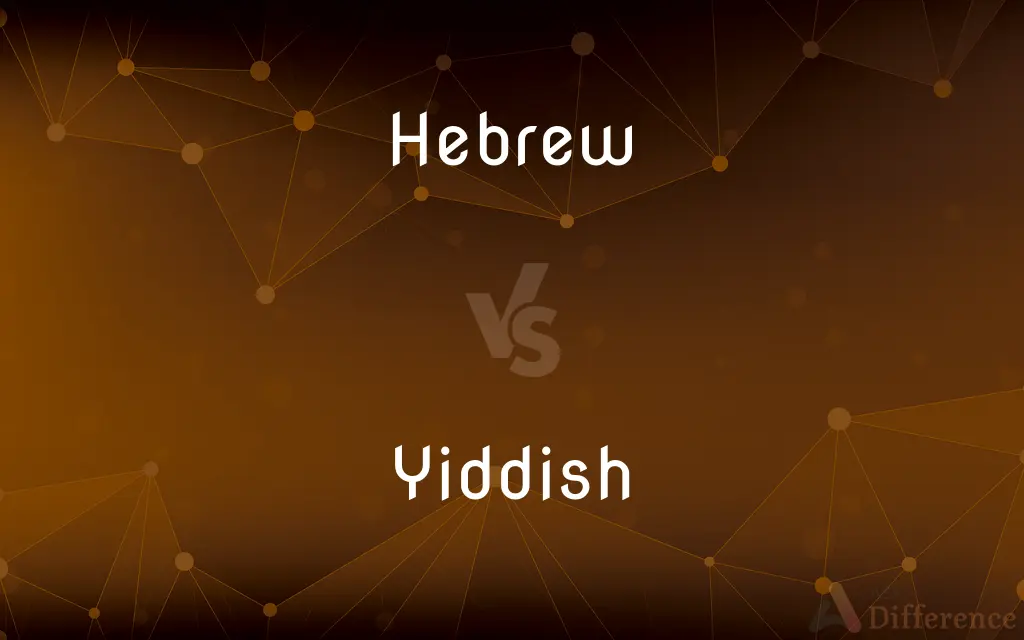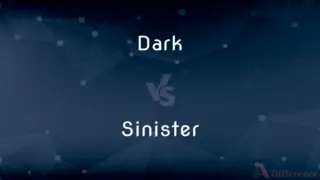Hebrew vs. Yiddish — What's the Difference?
By Tayyaba Rehman — Updated on September 23, 2023
Hebrew is an ancient Semitic language revived as the official language of Israel, while Yiddish is a High German-derived language historically spoken by Ashkenazi Jews.

Difference Between Hebrew and Yiddish
Table of Contents
ADVERTISEMENT
Key Differences
Hebrew and Yiddish are both languages associated with the Jewish community, but they have different origins and histories. Hebrew, an ancient Semitic language, traces its roots to the Israelites in the Middle East. It's the language of the Hebrew Bible and was historically spoken by ancient Israelites. Yiddish, on the other hand, developed among Ashkenazi Jewish communities in Central and Eastern Europe, incorporating elements from High German, Hebrew, and various Slavic languages.
While Hebrew experienced a period of dormancy as a spoken language, it was always preserved in Jewish liturgical, literary, and scholarly contexts. With the establishment of the State of Israel, Hebrew underwent a remarkable revival and became its official language. Yiddish, conversely, flourished as the vernacular of millions of Ashkenazi Jews, often being the language of daily life, literature, and theater.
In terms of script, both Hebrew and Yiddish use the Hebrew alphabet. However, their phonologies, vocabularies, and grammatical structures differ significantly. While Yiddish has borrowed a substantial number of words from Hebrew, it remains primarily a Germanic language in its grammar and core vocabulary.
Today, Hebrew is widely spoken in Israel and by Jewish communities worldwide, serving as a link to Jewish history and religious texts. Yiddish, while still spoken, especially among certain Orthodox Jewish groups, has seen a decline in daily use. Yet, it remains an essential component of Ashkenazi Jewish culture and history.
Comparison Chart
Origin
Semitic language from the Middle East
High German-derived language from Central and Eastern Europe
ADVERTISEMENT
Historical Speakers
Ancient Israelites
Ashkenazi Jews
Script
Hebrew alphabet
Hebrew alphabet (with variations for specific Yiddish sounds)
Core Vocabulary
Semitic
Primarily Germanic, with Slavic and Hebrew influences
Modern Usage
Official language of Israel, spoken by Jews worldwide
Spoken by some Ashkenazi Jewish communities, especially Orthodox groups
Compare with Definitions
Hebrew
The official language of Israel.
Children in Israel learn to read and write in Hebrew at school.
Yiddish
A High German-derived Jewish language.
Many older Ashkenazi Jews converse fluently in Yiddish.
Hebrew
Written using the Hebrew alphabet.
The Hebrew script is read from right to left.
Yiddish
Historically spoken by Ashkenazi Jews.
Yiddish literature offers a window into Ashkenazi Jewish life.
Hebrew
An ancient Semitic language.
The Hebrew Bible provides insights into early Jewish history.
Yiddish
Remains culturally significant for Ashkenazi Jews.
Yiddish theater and music are still celebrated today.
Hebrew
Experienced a modern revival.
The revival of spoken Hebrew is a unique linguistic phenomenon.
Yiddish
Incorporates Hebrew, German, and Slavic elements.
The Yiddish vocabulary is a blend of multiple languages.
Hebrew
A member of an ancient Semitic people claiming descent from Abraham, Isaac, and Jacob; an Israelite.
Yiddish
Used the Hebrew script with variations.
Yiddish writing often includes letters not found in standard Hebrew.
Hebrew
A descendant of this people; a Jew.
Yiddish
Yiddish (ייִדיש, יידיש or אידיש, yidish or idish, pronounced [ˈ(j)ɪdɪʃ], lit. 'Jewish'; ייִדיש-טײַטש, Yidish-Taytsh, lit. ' Judeo-German') is a West Germanic language historically spoken by Ashkenazi Jews. It originated during the 9th century in Central Europe, providing the nascent Ashkenazi community with a High German-based vernacular fused with many elements taken from Hebrew (notably Mishnaic) and to some extent Aramaic; most varieties also have substantial influence from Slavic languages, and the vocabulary contains traces of influence from Romance languages.
Hebrew
The Semitic language of the ancient Hebrews.
Yiddish
The language historically of Ashkenazic Jews of Central and Eastern Europe, resulting from a fusion of elements derived principally from medieval German dialects and secondarily from Hebrew and Aramaic, various Slavic languages, and Old French and Old Italian.
Hebrew
Any of the various later forms of this language, especially the language of the Israelis.
Yiddish
A language used by German and other Jews, being a Middle German dialect developed under Hebrew and Slavic influence. It is written in Hebrew characters.
Hebrew
Hebrews (used with a sing. verb) See Table at Bible.
Yiddish
A dialect of High German including some Hebrew and other words; spoken in Europe as a vernacular by many Jews; written in the Hebrew script
Hebrew
An appellative of Abraham or of one of his descendants, esp. in the line of Jacob; an Israelite; a Jew.
There came one that had escaped and told Abram the Hebrew.
Hebrew
The language of the Hebrews; - one of the Semitic family of languages.
Hebrew
Of or pertaining to the Hebrews; as, the Hebrew language or rites.
Hebrew
The ancient Canaanitic language of the Hebrews that has been revived as the official language of Israel
Hebrew
A person belonging to the worldwide group claiming descent from Jacob (or converted to it) and connected by cultural or religious ties
Hebrew
Of or relating to or characteristic of the Hebrews;
The old Hebrew prophets
Hebrew
Of or relating to the language of the Hebrews;
Hebrew vowels
Hebrew
Used in Jewish liturgy and religious texts.
Synagogue services often feature prayers in Hebrew.
Common Curiosities
Are Hebrew and Yiddish written the same way?
Both use the Hebrew alphabet, but Yiddish has variations for specific sounds.
Which language has Semitic roots?
Hebrew has Semitic roots, while Yiddish is primarily Germanic with some Semitic elements.
Is Hebrew older than Yiddish?
Yes, Hebrew predates Yiddish and is an ancient Semitic language.
Where did Yiddish originate?
Yiddish developed among Ashkenazi Jewish communities in Central and Eastern Europe.
Has Yiddish experienced a decline?
Yes, while still spoken by some communities, Yiddish has seen a decline in daily use.
Is Hebrew widely spoken today?
Yes, Hebrew is the official language of Israel and is spoken by Jewish communities worldwide.
What are the religious texts in Hebrew?
The Hebrew Bible and various Jewish liturgical texts are in Hebrew.
Can Yiddish speakers understand Hebrew automatically?
No, while Yiddish has borrowed from Hebrew, they are distinct languages.
Share Your Discovery

Previous Comparison
Pendant vs. Pennant
Next Comparison
Dark vs. SinisterAuthor Spotlight
Written by
Tayyaba RehmanTayyaba Rehman is a distinguished writer, currently serving as a primary contributor to askdifference.com. As a researcher in semantics and etymology, Tayyaba's passion for the complexity of languages and their distinctions has found a perfect home on the platform. Tayyaba delves into the intricacies of language, distinguishing between commonly confused words and phrases, thereby providing clarity for readers worldwide.













































